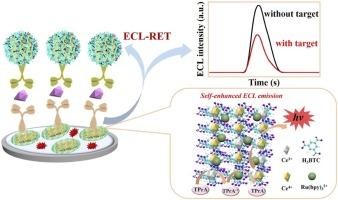基于自增强 Ce(III, IV)-MOF@Ru 到 CuO@PDA@AuNPs 的共振能量转移的多淬灭电化学发光系统,用于 HER2 的超灵敏检测
IF 8
1区 化学
Q1 CHEMISTRY, ANALYTICAL
引用次数: 0
摘要
本研究通过引入一种新的供体-受体耦合模式,提出了一种基于电化学发光共振能量转移(ECL-RET)的创新方法。自增强 Ce(III, IV)-MOF@Ru 的供体是通过在铈基金属有机框架(Ce(III, IV)-MOF)上固定 Ru(bpy)32+ 而产生的。CuO@PDA@AuNPs 的受体是接枝了金纳米粒子(AuNPs)的 CuO 纳米球聚多巴胺(PDA)框架。通过开发淬灭 ECL 免疫传感器,实现了对人表皮生长因子受体-2(HER2)的超灵敏检测。Ce(III,IV)-MOF 是一种独特的三维无限延伸框架,因其优异的纳米结构和显著的活化三丙胺(TPrA)并产生大量自由基的能力而得到认可。幸运的是,它同时被用作一种高效的核反应加速剂和封装剂,从而促进了 Ru(bpy)32+ 的固定和自由基的产生,形成了 Ce(III, IV)-MOF@Ru 自增强发射器。因此,通过有效缩短电子传输距离和减少能量损失,Ce(III, IV)-MOF@Ru 在 ECL 中实现了显著的高效率。更重要的是,制备出的 CuO@PDA@AuNPs 是一种完美的淬灭剂。CuO@PDA@AuNPs的紫外可见光谱与Ce(III, IV)-MOF@Ru的ECL光谱有部分重叠,从而有效地启动了供体和受体之间的ECL-RET相互作用。为了证明新获得的自增强纳米发射体和供体-受体偶联物的优越性,提出了一种用于分析 HER2 的 ECL 免疫分析方法,其检测范围为 0.2 fg/mL ~ 10 ng/mL,检测限为 0.067 fg/mL。因此,该方法为临床分析提供了便捷而重要的策略。本文章由计算机程序翻译,如有差异,请以英文原文为准。

Multi-quenching electrochemiluminescence system based on resonance energy transfer from self-enhanced Ce(III, IV)-MOF@Ru to CuO@PDA@AuNPs for ultrasensitive detection of HER2
This study presents an innovative approach based on electrochemiluminescence resonance energy transfer (ECL-RET) through the introduction of a new pattern donor-acceptor couple. The donor of self-enhanced Ce(III, IV)-MOF@Ru is created by immobilizing Ru(bpy)32+ on Ce-based metal-organic frameworks (Ce(III, IV)-MOF). The acceptor of CuO@PDA@AuNPs is the CuO nanospheres polydopamine (PDA) framework grafted with gold nanoparticles (AuNPs). An ultrasensitive detection of human epidermal growth factor receptor-2 (HER2) was achieved through the development of a quenched ECL immunosensor. Ce(III, IV)-MOF, a unique 3D infinite extension framework, was recognized for its excellent nanostructure and remarkable capacity to greatly activate tripropylamine (TPrA) and generate abundant radicals. Fortunately, it was simultaneously utilized as a highly effective coreactant accelerator and encapsulation agent, thereby facilitating the immobilization of Ru(bpy)32+ and the generation of radicals for creating a self-enhanced emitter of Ce(III, IV)-MOF@Ru. Consequently, by effectively reducing the distance of electron transmission and minimizing the loss of energy, Ce(III, IV)-MOF@Ru achieved a significantly high efficiency in ECL. More importantly, CuO@PDA@AuNPs was prepared as a perfect quenching agent. The ultraviolet-visible (UV–vis) spectra of CuO@PDA@AuNPs exhibited partial overlap with ECL spectra of Ce(III, IV)-MOF@Ru, thus efficiently initiating the ECL-RET interaction between the donor and acceptor. With the purpose of demonstrating the superiority of newly obtained self-enhanced nanoemitter and donor-acceptor couple, an ECL immunoassay was proposed for the analysis of HER2 with range of 0.2 fg/mL ∼ 10 ng/mL and the limit of detection of 0.067 fg/mL. Therefore, this method supplies convenient and significant strategy for the clinical analysis.
求助全文
通过发布文献求助,成功后即可免费获取论文全文。
去求助
来源期刊

Sensors and Actuators B: Chemical
工程技术-电化学
CiteScore
14.60
自引率
11.90%
发文量
1776
审稿时长
3.2 months
期刊介绍:
Sensors & Actuators, B: Chemical is an international journal focused on the research and development of chemical transducers. It covers chemical sensors and biosensors, chemical actuators, and analytical microsystems. The journal is interdisciplinary, aiming to publish original works showcasing substantial advancements beyond the current state of the art in these fields, with practical applicability to solving meaningful analytical problems. Review articles are accepted by invitation from an Editor of the journal.
 求助内容:
求助内容: 应助结果提醒方式:
应助结果提醒方式:


